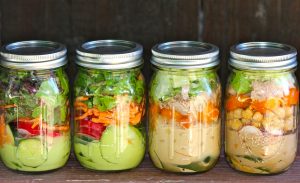Eating Frugal
One fun, easy, healthy way to save money on your grocery bill is to eat cheaply.
Here are some of our top tips on how to save money, beyond using coupons and saving strategies.
Strategy #1: Prepare Food in Batches
Imagine you buy lunch and spend $7. No big deal, right?
$7 x 5 = $35, x 50 weeks a year = $1,750/year on just lunch.
Bringing food from home might cost you $1.65 per lunch you can take outside or to a park saves you $5.35 a day, which is $26.75/week, which is $1,337.50 per year.
That’s per person. If a husband and wife do this, that’s $2,675 a year difference, which over 5 years adds up to $13,375.

The trick: Make a week’s worth of lunches on Sunday, if you work a traditional Mon-Fri type position. Go out once in a while as a treat, but pay close attention to daily habits. Make it a game, and the money you save try putting in a specific fund toward a specific goal. The delayed gratification will be a lot easier and more fun if you watch your savings get closer toward some specific goal, whether it be a family vacation, new car, rental property or something else tangible.
Batch preparation makes it not just easier instead of dealing with it each morning, it also makes it more likely you’ll stick to this plan. Vary the meals a bit.
TIP: Salads in jars can be fun, healthy, and easy! Put the salad dressing / oil / vinegar in 1st on the bottom, then just shake it when ready to eat.
TIP: Coffee brewed at home is cheap, but purchased on the go is expensive. If you pocketed $3.50/day for 30 years, invested into a Roth IRA, you’d have $106,000. We’re not saying never do it, but pay special attention to daily habits.
Strategy #2: Eat Lower on the Food Chain
Plants are cheaper than meat – and healthier to boot. $5 of beans can feed a family for a week, and can be made into dozens of options (chili, italian bean salads, bean burritos..). A single pound of beef requires an astounding 1,800 gallons of water – so the cost on the planet as well as your pocketbook is going to be higher than beans – and the beans definitely have all the protein you need. Plant-based athlete Rich Roll breaks down the cost of eating plant based meals:
Whether you’re a committed carnivore or vegan ironman or somewhere in between, eating more veggies is cheaper, not to mention better for your health and the environment.
By the way, a common concern among those new to plant-based diets is a concern for protein, but it’s a non-issue for almost all americans. Adult humans need .8 grams per kilogram of body weight, so a 125 pound human needs 45 to 57 grams per day (2 cups of lentils = 50 grams of protein, for example, or 34 cashews). Check out Men’s Health for proof you can beef up, without actually eating beef.
Strategy #3: Buy in Bulk
Costco and to some degree retailers like Wal-Mart make this easy, but what’s less obvious is looking for great sales, then stocking up. Also, ethnic markets in big cities sometimes have great prices on gourmet foods with higher markup than other stores. Taking the time to find a truly good bargain on long-term things you know you’ll consume like toothpaste, then buy a whole year’s supply. You know you’re going to use it, and if you use 2 tubes a month, the space to store 24 tubes isn’t any big deal – and saves you time and hassle even dealing with getting it in the house.
Naturally, this assumes you don’t live in a studio apartment or tiny house, but if you do, the storage costs may or may not outweigh the savings.

